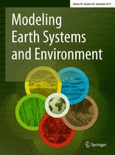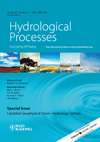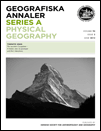
Earth Interactions
Scope & Guideline
Fostering Innovation in Earth and Planetary Research
Introduction
Aims and Scopes
- Climate Change Impacts:
The journal consistently focuses on the effects of climate change across various ecosystems and geographical regions, exploring how alterations in climate patterns influence hydrology, biodiversity, and human activities. - Hydrological Dynamics:
Research articles frequently delve into hydrological processes, including runoff variability, streamflow changes, and water balance modeling, highlighting the significance of water resources in the context of climate variability. - Ecosystem Services and Conservation:
The journal emphasizes the relationship between ecosystem services and conservation efforts, particularly through the lens of payment for ecosystem services, tourism, and land-use changes. - Land-Atmosphere Interactions:
A core area of research involves understanding land-atmosphere interactions and their implications for regional climate patterns, forest dynamics, and ecological responses. - Remote Sensing and Modeling:
The use of remote sensing technologies and modeling approaches is prevalent, facilitating the analysis of environmental changes, vegetation dynamics, and atmospheric behaviors.
Trending and Emerging
- Freshwater Ecosystem Dynamics:
Recent publications indicate a growing focus on freshwater ecosystems, particularly the effects of climate change on harmful algal blooms and water quality, reflecting increased concern over freshwater resources and their management. - Urban Agriculture and Sustainability:
The integration of urban agriculture within sustainability frameworks has gained traction, showcasing the importance of food systems in urban environments and their relationship with ecosystem services. - Climate Resilience and Adaptation Strategies:
Research on climate resilience, particularly in relation to hydrological extremes and adaptation strategies for communities, has become increasingly prominent, emphasizing the need for actionable solutions to climate-related challenges. - Equity and Justice in Environmental Research:
There is an emerging trend towards addressing equity, inclusion, and justice within environmental research, indicating a shift towards recognizing the social dimensions of environmental issues. - Telecoupling and Global Change:
The exploration of telecoupling—how distant places affect each other through environmental and socio-economic interactions—has emerged as a significant theme, highlighting the interconnectedness of global environmental changes.
Declining or Waning
- Historical Climate Reconstructions:
There has been a noticeable decrease in studies focusing on historical climate reconstructions and long-term climate variability, which were once prevalent. This may be due to a growing emphasis on contemporary issues and predictive modeling. - Socioeconomic Drivers of Environmental Change:
Research examining the socioeconomic factors driving environmental changes has become less frequent, indicating a possible shift towards more empirical environmental studies rather than interdisciplinary socio-environmental analyses. - Localized Environmental Studies:
Studies focusing on localized environmental phenomena, such as specific regional case studies, appear to be diminishing in favor of broader, more generalized analyses that address global or continental-scale issues.
Similar Journals

WETLANDS ECOLOGY AND MANAGEMENT
Illuminating the dynamics of aquatic ecosystems for a sustainable future.Wetlands Ecology and Management, published by Springer, is an esteemed journal that has been advancing the field of wetland studies since its inception in 1982. Operating under the ISSN 0923-4861 and E-ISSN 1572-9834, this journal is headquartered in the Netherlands and serves as a critical resource for researchers, professionals, and students alike. It fosters interdisciplinary dialogue among aquatic science, ecology, and resource management disciplines, ranking in the Q2 category for Aquatic Science and Ecology, Evolution, Behavior and Systematics as of 2023. With a notable Scopus ranking, it is positioned favorably within the 65th percentile in Ecology and a commendable 58th percentile in Aquatic Sciences. The journal emphasizes the importance of effective management strategies and policies in the conservation of wetlands, making it indispensable for those aiming to drive impactful research. Although it is not an open-access journal, its high-quality publications remain accessible through library consortia and institutional subscriptions, ensuring that pertinent insights into the ecological dynamics and sustainable management practices are available to the global research community.

Earth Systems and Environment
Transforming Insights into Action for Earth’s Well-beingEarth Systems and Environment, published by Springer International Publishing AG, is a leading peer-reviewed journal dedicated to the multidisciplinary study of natural and anthropogenic processes that shape the Earth's systems. With an impressive impact factor and consistently ranked in the Q1 category across various fields, including Computers in Earth Sciences, Economic Geology, and Environmental Science, it stands as a premier platform for researchers and professionals seeking to address pressing environmental challenges. The journal covers a wide spectrum of topics, from geology to global change, and emphasizes innovative methodologies and interdisciplinary approaches to understand and manage Earth systems. As an essential resource for scholars and practitioners, Earth Systems and Environment commits to excellence and facilitates open dialogue on critical issues affecting our planet.

Modeling Earth Systems and Environment
Exploring innovative modeling techniques for environmental challenges.Modeling Earth Systems and Environment is a premier interdisciplinary journal published by Springer Heidelberg, dedicated to advancing the understanding and modeling of Earth's systems and environmental processes. Since its inception in 2015, this journal has established itself as a vital resource within the academic community, attaining a Q1 ranking in Agricultural and Biological Sciences and Q2 rankings in Computers in Earth Sciences, Environmental Science, and Statistics, reflecting its high impact and relevance across multiple disciplines. Featuring rigorous peer-reviewed research, Modeling Earth Systems and Environment aims to bridge the gap between theory and practical application, fostering collaboration among researchers, professionals, and students alike. With access options that prioritize the dissemination of knowledge, this journal is crucial for those seeking to contribute to the fields of environmental modeling and systems science, encouraging innovations that address contemporary environmental challenges.

Vietnam Journal of Earth Sciences
Bridging Local Insights with Global Impact in Earth SciencesThe Vietnam Journal of Earth Sciences, ISSN 0866-7187, is a premier publication from the Publishing House Science and Technology based in Viet Nam, dedicated to fostering advancements in the field of Earth and Planetary Sciences. Operating under a Q2 ranking in the 2023 category of Earth and Planetary Sciences (miscellaneous) and positioned at Rank #62 out of 195 in its general category on Scopus, this journal serves as a critical platform for researchers, professionals, and students seeking to disseminate and engage with high-quality scientific findings. Despite being part of the non-open access model, the journal is committed to providing compelling content, encompassing a range of topics from geological hazards to environmental sustainability, ensuring its relevance and contribution to both local and international scientific communities. With coverage that spans from 2018 to 2024, the journal is poised to continue its role in addressing pressing Earth science issues and fostering collaborations among scholars in an increasingly interconnected world.

Physio-Geo
Connecting Disciplines, Transforming KnowledgePhysio-Geo (ISSN: 1958-573X) is a distinguished open-access journal published by REVUES ORG, dedicated to advancing the fields of Earth and Planetary Sciences, with a special focus on Earth-Surface Processes, Environmental Science, and Ecology. Since its inception in 2007, Physio-Geo has provided a platform for researchers, professionals, and students to disseminate and access high-quality studies that contribute to the understanding of our environment. With a convergence period from 2019 to 2024, the journal aims to bridge disciplinary gaps and foster interdisciplinary research that addresses pressing ecological and environmental challenges. Despite its current Scopus rankings reflecting an early-stage development, the journal is poised to enhance its impact within the scientific community, particularly as it embraces a wider audience through its open-access model. By offering valuable insights and comprehensive analyses, Physio-Geo is an essential resource for those seeking to explore the complex interactions between physical geography and ecological systems.

PHYSICS AND CHEMISTRY OF THE EARTH
Bridging Geophysics and Geochemistry for Groundbreaking ResearchThe Physics and Chemistry of the Earth is a premier interdisciplinary journal published by Pergamon-Elsevier Science Ltd, dedicated to advancing the understanding of Earth sciences through the integration of geophysical and geochemical perspectives. With an ISSN of 1474-7065 and an E-ISSN of 1873-5193, the journal serves as a critical platform for researchers and professionals to disseminate key findings and innovative methodologies in the realms of geophysics and petrology. As of 2023, it proudly holds a Q2 ranking in both Geochemistry and Petrology and Geophysics, reflecting its robust impact in the scientific community, with Scopus rankings that position it in the top 20% and 32% of its respective categories. Notably, the journal is available in an open-access format, allowing for greater dissemination and accessibility of research contributions. With a publication history spanning from 1992 to 2024, Physics and Chemistry of the Earth stands as a vital resource for ongoing research and discovery in the Earth sciences, making it an essential read for academics and practitioners alike.

WETLANDS
Advancing Wetland Science for a Sustainable FutureWETLANDS is a prestigious academic journal dedicated to advancing the understanding of wetland ecosystems, published by SPRINGER and based in the Netherlands. Established in 1981, this journal has consistently offered high-quality research on ecological dynamics, environmental chemistry, and broader environmental science topics, as indicated by its notable rankings in the 2023 category quartiles: Q2 in Ecology and Environmental Science (miscellaneous) and Q3 in Environmental Chemistry. The journal impacts the scientific community significantly, as reflected in its Scopus rankings, which place it within the top percentiles of its field. This makes WETLANDS an essential resource for researchers, professionals, and students aiming to stay at the forefront of wetland research and conservation efforts. With continual contributions from experts worldwide, it not only disseminates critical findings but also fosters collaboration and innovation within this vital area of environmental science.

Carpathian Journal of Earth and Environmental Sciences
Fostering Collaboration in Earth and Environmental ResearchCarpathian Journal of Earth and Environmental Sciences is a distinguished academic journal dedicated to advancing the interdisciplinary field of Earth and environmental sciences. Published by the Carpathian Association for Environment and Earth Sciences, this journal plays a pivotal role in disseminating high-quality research focused on the dynamic interactions between geological processes and environmental changes. With an ISSN of 1842-4090 and an E-ISSN of 1844-489X, the journal is indexed in Scopus and holds an esteemed Q3 quartile ranking in both Earth and Planetary Sciences and Environmental Science categories as of 2023. Since its inception in 2008, the Carpathian Journal has provided an open access platform for researchers, professionals, and students to share insights, foster collaboration, and engage in critical discussions on pressing environmental issues. By continuously contributing to the body of knowledge in this field, the journal not only enhances academic discourse but also promotes sustainable environmental practices across Romania and beyond.

HYDROLOGICAL PROCESSES
Exploring the Dynamics of Water ScienceHYDROLOGICAL PROCESSES, published by WILEY, stands as a leading journal in the realm of Water Science and Technology. With an impressive impact factor and a prestigious ranking of Q1 in its category, the journal has carved a niche for itself since its inception in 1986, continuing to disseminate insightful research through to 2024. It boasts a solid Scopus ranking, sitting at #59 out of 261 in the Environmental Science field, placing it in the 77th percentile and emphasizing its relevance in the study of hydrological dynamics. Although not an open access journal, it provides essential and impactful articles that contribute to understanding hydrological phenomena, ensuring broad accessibility through libraries and institutional subscriptions. Researchers, professionals, and students alike will find HYDROLOGICAL PROCESSES a vital resource for the latest studies and advancements in water resource management and environmental sustainability.

GEOGRAFISKA ANNALER SERIES A-PHYSICAL GEOGRAPHY
Charting New Paths in Earth and Planetary SciencesGeografiska Annaler Series A-Physical Geography, published by Taylor & Francis Ltd, is a leading academic journal dedicated to the advancing field of physical geography. With a rich publication history spanning from 1979 to 2024, this journal stands out in its categories, being positioned in the Q2 quartile for both Geography, Planning and Development and Geology in 2023. The journal is recognized for its contribution to Earth and Planetary Sciences, evidenced by its Scopus rankings placing it in the top 31% and 32% of its respective disciplines. Belonging to a distinguished publisher from the United Kingdom, it provides a vital platform for researchers, professionals, and students to disseminate and engage with cutting-edge research. While the journal does not currently offer open access, it remains a pivotal resource for those involved in the study of physical geography, offering insights that enhance our understanding of the Earth's processes and environments.